26S proteasome non-ATPase regulatory subunit 12 is an enzyme that in humans is encoded by the PSMD12 gene. [5]
26S proteasome non-ATPase regulatory subunit 12 is an enzyme that in humans is encoded by the PSMD12 gene. [5]
The 26S proteasome is a multicatalytic proteinase complex with a highly ordered structure composed of 2 complexes, a 20S core and a 19S regulator. The 20S core is composed of 4 rings of 28 non-identical subunits; 2 rings are composed of 7 alpha subunits and 2 rings are composed of 7 beta subunits. The 19S regulator is composed of a base, which contains 6 ATPase subunits and 2 non-ATPase subunits, and a lid, which contains up to 10 non-ATPase subunits. Proteasomes are distributed throughout eukaryotic cells at a high concentration and cleave peptides in an ATP/ubiquitin-dependent process in a non-lysosomal pathway. An essential function of a modified proteasome, the immunoproteasome, is the processing of class I MHC peptides. This gene encodes a non-ATPase subunit of the 19S regulator. A pseudogene has been identified on chromosome 3. [6]
The proteasome and its subunits are of clinical significance for at least two reasons: (1) a compromised complex assembly or a dysfunctional proteasome can be associated with the underlying pathophysiology of specific diseases, and (2) they can be exploited as drug targets for therapeutic interventions. More recently, more effort has been made to consider the proteasome for the development of novel diagnostic markers and strategies. An improved and comprehensive understanding of the pathophysiology of the proteasome should lead to clinical applications in the future.
The proteasomes form a pivotal component for the ubiquitin–proteasome system (UPS) [7] and corresponding cellular Protein Quality Control (PQC). Protein ubiquitination and subsequent proteolysis and degradation by the proteasome are important mechanisms in the regulation of the cell cycle, cell growth and differentiation, gene transcription, signal transduction and apoptosis. [8] Subsequently, a compromised proteasome complex assembly and function lead to reduced proteolytic activities and the accumulation of damaged or misfolded protein species. Such protein accumulation may contribute to the pathogenesis and phenotypic characteristics in neurodegenerative diseases, [9] [10] cardiovascular diseases, [11] [12] [13] inflammatory responses and autoimmune diseases, [14] and systemic DNA damage responses leading to malignancies. [15]
Several experimental and clinical studies have indicated that aberrations and deregulations of the UPS contribute to the pathogenesis of several neurodegenerative and myodegenerative disorders, including Alzheimer's disease, [16] Parkinson's disease [17] and Pick's disease, [18] Amyotrophic lateral sclerosis (ALS), [18] Huntington's disease, [17] Creutzfeldt–Jakob disease, [19] and motor neuron diseases, polyglutamine (PolyQ) diseases, Muscular dystrophies [20] and several rare forms of neurodegenerative diseases associated with dementia. [21] As part of the ubiquitin–proteasome system (UPS), the proteasome maintains cardiac protein homeostasis and thus plays a significant role in cardiac ischemic injury, [22] ventricular hypertrophy [23] and heart failure. [24] Additionally, evidence is accumulating that the UPS plays an essential role in malignant transformation. UPS proteolysis plays a major role in responses of cancer cells to stimulatory signals that are critical for the development of cancer. Accordingly, gene expression by degradation of transcription factors, such as p53, c-jun, c-Fos, NF-κB, c-Myc, HIF-1α, MATα2, STAT3, sterol-regulated element-binding proteins and androgen receptors are all controlled by the UPS and thus involved in the development of various malignancies. [25] Moreover, the UPS regulates the degradation of tumor suppressor gene products such as adenomatous polyposis coli (APC) in colorectal cancer, retinoblastoma (Rb). and von Hippel–Lindau tumor suppressor (VHL), as well as a number of proto-oncogenes (Raf, Myc, Myb, Rel, Src, Mos, ABL). The UPS is also involved in the regulation of inflammatory responses. This activity is usually attributed to the role of proteasomes in the activation of NF-κB which further regulates the expression of pro inflammatory cytokines such as TNF-α, IL-β, IL-8, adhesion molecules (ICAM-1, VCAM-1, P-selectin) and prostaglandins and nitric oxide (NO). [14] Additionally, the UPS also plays a role in inflammatory responses as regulators of leukocyte proliferation, mainly through proteolysis of cyclines and the degradation of CDK inhibitors. [26] Lastly, autoimmune disease patients with SLE, Sjögren syndrome and rheumatoid arthritis (RA) predominantly exhibit circulating proteasomes which can be applied as clinical biomarkers. [27]
Gene expression levels of the proteasomal subunits (PSMA1, PSMA5, PSMB4, PSMB5 and PSMD1) were investigated in 80 patients with neuroendocrine pulmonary tumors and compared to controls. The study reviled that PSMB4 mRNA was significantly associated with proliferative activity of neuroendocrine pulmonary tumors. [28] However, a role of PSMA5 was also indicated in neuroendocrine pulmonary tumors. The PSMA5 protein has further been associated with the biosynthesis of conjugated linoleic acid (CLA) in mammary tissue. [29]

Proteasome subunit alpha type-4 also known as macropain subunit C9, proteasome component C9, and 20S proteasome subunit alpha-3 is a protein that in humans is encoded by the PSMA4 gene. This protein is one of the 17 essential subunits that contributes to the complete assembly of 20S proteasome complex.

Proteasome subunit beta type-1 also known as 20S proteasome subunit beta-6 is a protein that in humans is encoded by the PSMB1 gene. This protein is one of the 17 essential subunits that contributes to the complete assembly of 20S proteasome complex. In particular, proteasome subunit beta type-1, along with other beta subunits, assemble into two heptameric rings and subsequently a proteolytic chamber for substrate degradation. The eukaryotic proteasome recognized degradable proteins, including damaged proteins for protein quality control purpose or key regulatory protein components for dynamic biological processes. An essential function of a modified proteasome, the immunoproteasome, is the processing of class I MHC peptides.
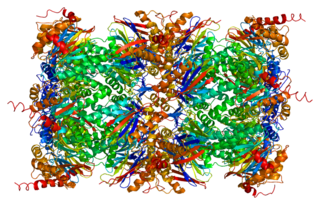
Proteasome subunit beta type-4 also known as 20S proteasome subunit beta-7 is a protein that in humans is encoded by the PSMB4 gene.

26S proteasome non-ATPase regulatory subunit 10 or gankyrin is an enzyme that in humans is encoded by the PSMD10 gene. Gankyrin is an oncoprotein that is a component of the 19S regulatory cap of the proteasome. Structurally, it contains a 33-amino acid ankyrin repeat that forms a series of alpha helices. It plays a key role in regulating the cell cycle via protein-protein interactions with the cyclin-dependent kinase CDK4. It also binds closely to the E3 ubiquitin ligase MDM2, which is a regulator of the degradation of p53 and retinoblastoma protein, both transcription factors involved in tumor suppression and found mutated in many cancers. Gankyrin also has an anti-apoptotic effect and is overexpressed in certain types of tumor cells such as hepatocellular carcinoma.

26S proteasome non-ATPase regulatory subunit 13 is an enzyme that in humans is encoded by the PSMD13 gene.
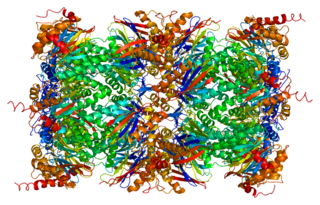
Proteasome subunit beta type-2 also known as 20S proteasome subunit beta-4 is a protein that in humans is encoded by the PSMB2 gene. This protein is one of the 17 essential subunits that contributes to the complete assembly of 20S proteasome complex. In particular, proteasome subunit beta type-2, along with other beta subunits, assemble into two heptameric rings and subsequently a proteolytic chamber for substrate degradation. The eukaryotic proteasome recognized degradable proteins, including damaged proteins for protein quality control purpose or key regulatory protein components for dynamic biological processes. An essential function of a modified proteasome, the immunoproteasome, is the processing of class I MHC peptides.

Proteasome subunit beta type-3, also known as 20S proteasome subunit beta-3, is a protein that in humans is encoded by the PSMB3 gene. This protein is one of the 17 essential subunits that contribute to the complete assembly of the 20S proteasome complex. In particular, proteasome subunit beta type-2, along with other beta subunits, assemble into two heptameric rings and subsequently a proteolytic chamber for substrate degradation. The eukaryotic proteasome recognizes degradable proteins, including damaged proteins for protein quality control purpose or key regulatory protein components for dynamic biological processes.

26S proteasome non-ATPase regulatory subunit 5 is an enzyme that in humans is encoded by the PSMD5 gene.

Proteasome subunit alpha type-1 is a protein that in humans is encoded by the PSMA1 gene. This protein is one of the 17 essential subunits that contributes to the complete assembly of 20S proteasome complex.

Proteasome subunit alpha type-7 also known as 20S proteasome subunit alpha-4 is a protein that in humans is encoded by the PSMA7 gene. This protein is one of the 17 essential subunits that contributes to the complete assembly of 20S proteasome complex.
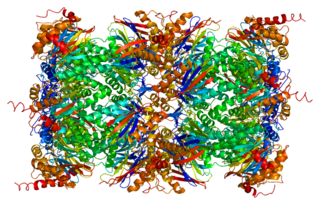
Proteasome subunit beta type-5 as known as 20S proteasome subunit beta-5 is a protein that in humans is encoded by the PSMB5 gene. This protein is one of the 17 essential subunits that contributes to the complete assembly of 20S proteasome complex. In particular, proteasome subunit beta type-5, along with other beta subunits, assemble into two heptameric rings and subsequently a proteolytic chamber for substrate degradation. This protein contains "chymotrypsin-like" activity and is capable of cleaving after large hydrophobic residues of peptide. The eukaryotic proteasome recognized degradable proteins, including damaged proteins for protein quality control purpose or key regulatory protein components for dynamic biological processes. An essential function of a modified proteasome, the immunoproteasome, is the processing of class I MHC peptides.

26S proteasome non-ATPase regulatory subunit 7, also known as 26S proteasome non-ATPase subunit Rpn8, is an enzyme that in humans is encoded by the PSMD7 gene.
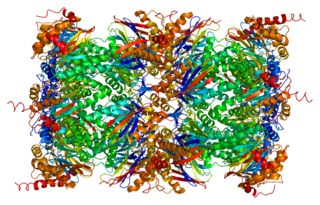
Proteasome subunit alpha type-5 also known as 20S proteasome subunit alpha-5 is a protein that in humans is encoded by the PSMA5 gene. This protein is one of the 17 essential subunits that contributes to the complete assembly of 20S proteasome complex.
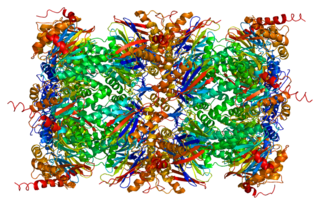
Proteasome subunit beta type-7 as known as 20S proteasome subunit beta-2 is a protein that in humans is encoded by the PSMB7 gene.

26S proteasome non-ATPase regulatory subunit 1, also as known as 26S Proteasome Regulatory Subunit Rpn2, is a protein that in humans is encoded by the PSMD1 gene. This protein is one of the 19 essential subunits that contributes to the complete assembly of 19S proteasome complex.

26S proteasome non-ATPase regulatory subunit 2, also as known as 26S Proteasome Regulatory Subunit Rpn1, is an enzyme that in humans is encoded by the PSMD2 gene.

26S proteasome non-ATPase regulatory subunit 11 is an enzyme that in humans is encoded by the PSMD11 gene.

26S proteasome non-ATPase regulatory subunit 8 is an enzyme that in humans is encoded by the PSMD8 gene.

26S proteasome non-ATPase regulatory subunit 9 is an enzyme that in humans is encoded by the PSMD9 gene.

26S proteasome non-ATPase regulatory subunit 3 is an enzyme that in humans is encoded by the PSMD3 gene.